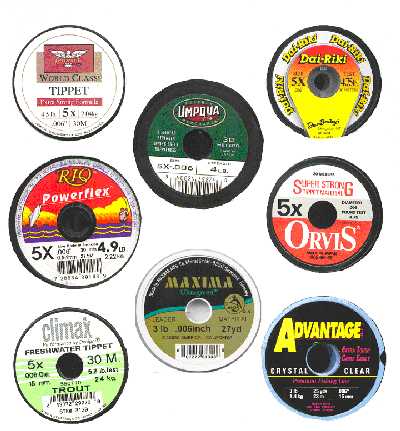This feature is best viewed with Netscape Navigator or with the ‘small fonts’ option in Internet Explorer.
The several brands shown above were tested to determine the absolute and relative performance characteristics. The 5X diameter (0.006″) was chosen because it is in the range of 4X to 6X most commonly used as tippets in trout fishing and where, due to the fragile nature of fine tippets, knot strength, elongation and abrasion resistance are most important.
The following shows and provides a discussion of the results.
INTRODUCTION
What should we look for when selecting leader material? There is no simpleanswer, because the need changes with the application. To start with thereare three general types of leaders: Tapered, linear and big game. Where thedesirable characteristics of the various parts of each vary considerably.However, there is one thing for certain: it is impossible to obtain enoughinformation from the labels on the dispensing spools (or distributor advertisingclaims) to select the best material.
All that can be determined from the labels is the advertised dry break strength(usually overstated) and the specified diameter that often isn’t matchedby the material on the spool. Knowing the “Break Strength” doesn’t help selectthe best material because we won’t know how much energy will be requiredto reach the breaking strain. As an example: if there were two frames, oneholding a sheet of glass and the other a sheet of rubber, each with the same”breaking strength”, dropping a weight sufficient to break the glass, onboth sheets, would not break the rubber sheet because the energy requiredto stretch the rubber to the breaking point is much greater than for theglass. So, Choosing from the sport shop rack, based upon the labels, is something like playing Russian Roulette.
To make a valid selection, we need to know the energy per foot required tobreak the material, the effect on strength caused by a wind knot (“knotstrength”) and the relative effect of abrasion. Further, these must be thecharacteristics exhibited after the material has been soaked in water.
Few of us have the lab equipment to make these measurements. So we end updepending upon the advice and recommendations from sport shops, guides and fishing partners. Unfortunately, most of them don’t know either and basetheir advice on experience and/or hearsay, which, although helpful, probablywon’t produce the most desirable assembly.
Methods were devised to make the required measurements using materials and devices commonly found at home or easily obtained at a hardware store – nothing fancy.
THE MEASUREMENTS
Prior to the measurements the leader material is soaked in water for onehour and then kept in zip bags with a wet sponge until used. The characteristics that must be measured and/or calculated are:
1. a) Break Strength: ……………………………………………(B) = (Strain required to break the material).













